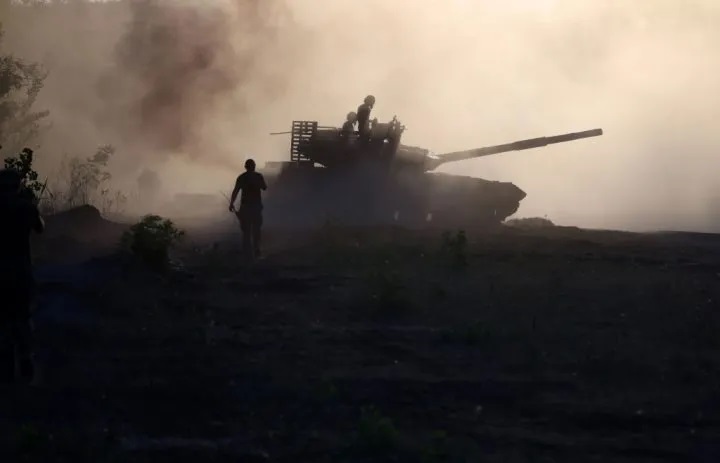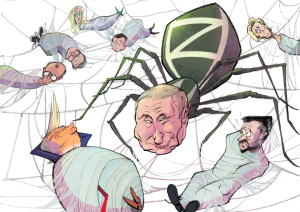For the first time since the World War Two, foreign forces have invaded Russia. As Ukrainian troops push over the border into the Kursk region, Vladimir Putin, with breathtaking lack of irony, denounces this as “terrorism” and a “provocation.” But what is Kyiv’s goal?
Previous incursions, largely into the Belgorod region, have been carried out by small units of pro-Kyiv Russia troops, so although they are in practice controlled by HUR, Ukrainian military intelligence, this could be spun as “liberation” by anti-Putin forces. However, these have also been little more than PR exercises: a dash across the border to take some half-defended villages, some selfies and a hurried withdrawal.
The Kursk offensive is unlikely to penetrate far
The Kursk attack, though, is rather different — not least as it is being conducted by Ukrainian troops, including elements of the relatively elite 22nd Mechanized Brigade and 82nd Air Assault Brigade, equipped with US-made Stryker armored fighting vehicles. It is also on a much more serious scale, so far involving over a thousand troops and with the apparent goal of holding some territory, at least for a while.
;768:[300×250,336×280,320×100];0:[300×250,320×100,320×50]”]Although the Russians did start delivering disruptive strikes on the Ukrainians’ assembly points around the nearby Ukrainian city of Sumy on the eve of the attack, they seem to have been anticipating a smaller operation. Initially, then, the attackers were only really met by border troops and some smaller units of conscripts. In short order, they pushed some six miles along a thirty-five-mile front, reaching and apparently taking the Russian town of Sudzha.
Despite some inflated description of Sudzha as a “city,” it is a small town which had a population of under 6,000 (comparable to such British metropola as Welshpool and Fort William). However, it has strategic importance as the site of a gas metering station on the Urengoy-Pomary-Uzhhorod pipeline through which flows about half of the gas still supplied to Europe.
This may provide one answer to the reason as to why Kyiv has chosen to make this attack now, at a time when it is slowly being ground back by the Russians along the Donbas front to the east. The initial assumption was that it was essentially a bid to panic Moscow into transferring troops from that offensive to the Kursk line. However, that seemed to make little sense: Kyiv’s over-stretched troops are needed there, and Moscow has greater reserves, especially as it can draw on conscript forces — which it cannot send into Ukraine for legal and political reasons — for defense of its own territory.
Of course, Kyiv could always have simply broken the pipeline, but that would have angered Hungary, Slovakia, Austria and the Czech Republic. It would also have deprived it of earnings — the irony is that even while at war, Ukraine earns over $750 million a year in transit fees under a deal expiring at the end of this year. Control of Sudzha, granting Ukraine the power to turn the gas supply on and off, might be considered a powerful symbol of its continuing agency, and the need to take it seriously.
That may well be a significant aspect of the operation: changing the narrative. Even though Ukraine has just received long-awaited F-16 fighters and more support is on the way, it has been a hard year and there is a lurking suspicion in Kyiv that there is a growing desire to see it reach some kind of a deal with Russia. Given that, in the current circumstances, this would inevitably mean territorial concessions, there is a desire to dispel any sense that Ukraine is on the ropes.
;768:[300×250,336×280,320×100];0:[300×250,320×100,320×50]”]The Kursk offensive is unlikely to penetrate far. Although flying columns have driven another twenty miles along highways to threaten the small town of Korenevo north-west of Sudzha and the village of Anastas’evka to the north, the prospects of further progress to such targets as Kursk city or the Kursk nuclear power plant (some fifty and forty miles further, respectively) seem unlikely. Nonetheless, Putin has been forced to declare a state of emergency in the Kursk region, apoplectic “turbo-patriot” online commentators are calling for generals’ heads and the state propagandists are desperately trying to square this attack with their complacent assessments of a week ago. Already, the official media has declared victory six times, yet the incursion continues. Once again, a nimble Ukraine has wrong-footed ponderous Russia.
Yet does this really matter? Time will tell if it was a sensible gamble or not, but those Strykers could have been put to good use in the desperate defense of such Donbas bastions as Chasyv Yar, and already the Ukrainians are losing men and materiel. Taking villages against scattered light forces taken unawares is also a great deal more straightforward that holding them, especially as Russian airpower and Lancet loitering munitions start to take their toll on Ukraine’s supply lines. Call it audacity or call its desperation, but the attack clearly demonstrates that Kyiv felt the need to change the narrative.
This article was originally published on The Spectator’s UK website.


























Leave a Reply